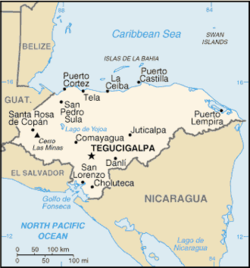Tegucigalpa | |
|---|---|
| Nickname(s): Tegus Tepaz Cerro de Plata (Silver Mountain) | |
 | |
| Country | Honduras |
| Department | Francisco Morazán |
| Municipality | Distrito Central |
| Founded | 1578 |
| Capital | 1880 |
| Merged as Distrito Central | 1938 |
| Government | |
| • Type | Democratic Municipality |
| Area | |
| • City | 800 km2 (290 sq mi) |
| Elevation | 990 m (3,250 ft) |
| Population (2006) | |
| • City | 894,000 |
| • Metro | 1,324,000 |
Tegucigalpa, the capital city of Honduras, is located in a central mountainous region having a tropical climate within the Choluteca river basin. Major rivers supplying the capital city are the Choluteca and Guacerique rivers which then fill the Concepción and Laureles storage reservoirs. With an urban population of approximately 900,000 and another 400,000 living in the surrounding neighborhoods, Tegucigalpa is being confronted with an array of imposing integrated urban water management (IUWM) challenges. Potable water coverage is poor with around 40% of the city's residents without access to piped water supply thus relying on more costly water trucks and bottled water.[1]
Furthermore, the capital city lies within a geographic depression amongst the surrounding mountain range making the city prone to flooding and landslides with both occurring in 1998 when Hurricane Mitch passed through Tegucigalpa killing 180 people and leaving many more displaced. Other critical IUWM issues include: inadequate water quality and quantity levels, deteriorating watersheds, rivers, and storage reservoirs, inefficient water use, rapid and poorly planned urbanization, intensive competition between industrial and domestic water users as well as irrigation demands, and industrial and domestic effluents discharging into the rivers, tributaries, and reservoirs without treatment.
Overcoming these challenges has been difficult for SANAA (Servicio Autonomo Nacional de Acueductos y Alcantarillados), the state-run water and sewerage utility in Tegucigalpa. SANAA's funding and roles are becoming uncertain as Honduras continues to decentralize SANAA's functions and transfer SANAA assets to municipalities. The decentralization process began with the 2003 Water Framework Law and further progressed with the passing of new legal and institutional initiatives such as the General Water Law (2009) and subsequent National Water Authority.[1]
The General Water Law and the National Water Authority are efforts to address IUWM challenges in Tegucigalpa and throughout Honduras. The National Water Authority replaces the General Directorate of Water Resources and will continue with an oversight function of the decentralized institutional framework including the work of SANAA.[2]
- ^ a b Cite error: The named reference
World Bankwas invoked but never defined (see the help page). - ^ Honduras laboral-Comun (2009). "Quién administrará el agua?". Honduras Laboral-Comun. Retrieved 2009-07-30.
© MMXXIII Rich X Search. We shall prevail. All rights reserved. Rich X Search
